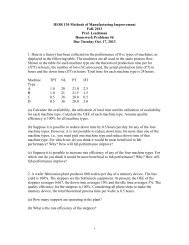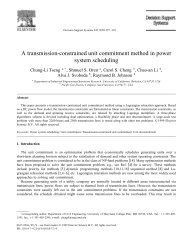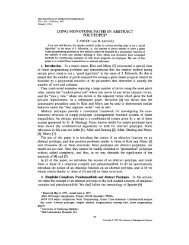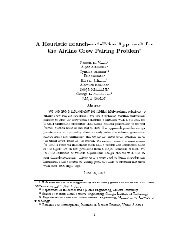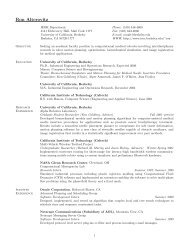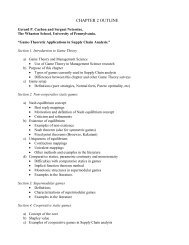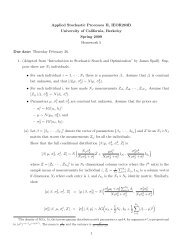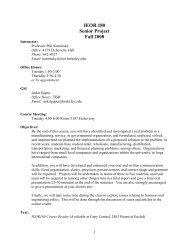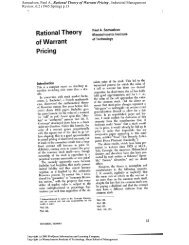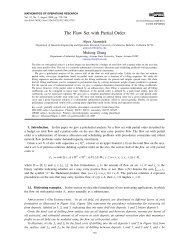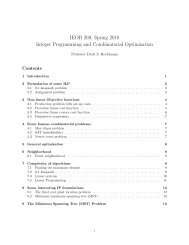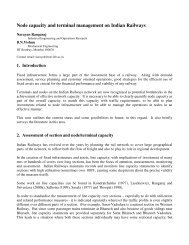a strongly polynomial algorithm for a special class of linear programs
a strongly polynomial algorithm for a special class of linear programs
a strongly polynomial algorithm for a special class of linear programs
Create successful ePaper yourself
Turn your PDF publications into a flip-book with our unique Google optimized e-Paper software.
Maximize yi<br />
subjecto A Ty < C<br />
which contradicts that y Tax is infinite.<br />
Permute the rows and columns <strong>of</strong> A so that<br />
A =AMN,1 AmN2 AI A2)<br />
0 AM2N2J 0 A3J<br />
From the pro<strong>of</strong> <strong>of</strong> the lemma, if P is feasible, then<br />
A1 is a Leontief submatrix <strong>of</strong> A. So the system,<br />
A [TYM, CN, has a finite maximal solution, ymax. Since<br />
bM, is nonnegative and bM2 = 0, we can conclude that<br />
the vector y* = (YM,x, YM2) is an optimal solution to<br />
D, where DM2 satisfies<br />
A3 YM2 C2 - A2 M<br />
(Note that the existence <strong>of</strong> a feasible solution to this<br />
system is assured because <strong>for</strong> each i E M2, y7 ax iS<br />
infinite, hence, larger than y7 in. It could be found in<br />
O(m2n) time (Aspvall and Shiloach).<br />
From duality theory and Proposition 1, if y* is an<br />
optimal solution to D, then an optimal solution to P<br />
is x* = (xs, 0), which can be obtained by finding a<br />
feasible solution to the system<br />
AM,SXS = bM, xs _ 0<br />
where S = {j E N1 I (A Ty*)j = cj}. Since y Tax is finite<br />
<strong>for</strong> all i E M1, this can be accomplished by the<br />
methodology described in the previous section. Thus,<br />
we have proved the following theorem.<br />
Theorem 1. IfA is a pre-Leontief matrix with no more<br />
than two nonzero elements in any column, then optimal<br />
solutions to P and D, where b > 0, if they exist,<br />
can befound in O(m3n log n) time.<br />
Corollary. Any instance <strong>of</strong> GTP with either b < 0 or<br />
b > 0 can be solved in <strong>strongly</strong> <strong>polynomial</strong> time.<br />
(Note that <strong>for</strong> GTP, the statements made above apply<br />
to the case where b < 0, because <strong>for</strong> GTP -Ax = -b,<br />
x > 0 is also a pre-Leontief substitution system.)<br />
3. REMARKS<br />
After having found efficient solution techniques <strong>for</strong><br />
LPs with a constraint set which comprises an LSS<br />
whose variables appear in no more than two constraints,<br />
we are curious as to whether there are other<br />
<strong>class</strong>es <strong>of</strong> LPs with Leontief constraint matrices <strong>for</strong><br />
which an efficient <strong>algorithm</strong> can be found. It seems<br />
that the <strong>special</strong> properties associated with these prob-<br />
A StronglyPolynomialAlgorithm For LPs / 959<br />
lems can be exploited to allow <strong>for</strong> a <strong>strongly</strong> <strong>polynomial</strong><br />
<strong>algorithm</strong> <strong>for</strong> a more general <strong>class</strong> <strong>of</strong> problems,<br />
particularly since there is a characterization <strong>of</strong> feasible<br />
bases which is not dependent on the particular values<br />
<strong>of</strong> the numbers in the constraint matrix.<br />
Jeroslow et al. ( 1989) describe properties associated<br />
with a <strong>class</strong> <strong>of</strong> LSS, which are called "gainfree." By<br />
exploiting some hypergraph representation <strong>of</strong> the system,<br />
they have shown that the <strong>class</strong> <strong>of</strong> LPs with a<br />
gainfree Leontief constraint matrix can be solved in<br />
<strong>strongly</strong> <strong>polynomial</strong> time. They also show that since<br />
primal feasible bases <strong>for</strong> these LPs are triangular,<br />
instances with an integral constraint matrix and<br />
rational right-hand side are totally dual integral.<br />
The notion <strong>of</strong> parameterized searching, which was<br />
originally introduced by Megiddo (1979), has proven<br />
to be a very useful tool <strong>for</strong> <strong>algorithm</strong>ic development.<br />
Per<strong>for</strong>ming a parameterized search, in place <strong>of</strong>, say, a<br />
series <strong>of</strong> binary searches not only helps in improving<br />
the running time <strong>of</strong> existing <strong>algorithm</strong>s, but has led<br />
the way <strong>for</strong> the development <strong>of</strong> new efficient <strong>algorithm</strong>s.<br />
Adler and Cosares (1989) describe a "nested"<br />
version <strong>of</strong> the technique which has led the way <strong>for</strong> the<br />
solution <strong>of</strong> additional <strong>class</strong>es <strong>of</strong> the LP problem in<br />
<strong>strongly</strong> <strong>polynomial</strong> time.<br />
ACKNOWLEDGMENT<br />
This research was partially funded by the United States<br />
Office <strong>of</strong> Naval Research under contract N000 14-87-<br />
K-0202. Their support is gratefully acknowledged.<br />
The authors also wish to thank the anonymous<br />
referees <strong>for</strong> their helpful comments.<br />
REFERENCES<br />
ADLER, I., AND S. COSARES. 1989. Nested Parameterized<br />
Searching and a Class <strong>of</strong> Strongly Polynomially Solvable<br />
Linear Programs. Working Paper, University<br />
<strong>of</strong> Cali<strong>for</strong>nia, Berkeley.<br />
ASPVALL, B., AND Y. SHILOACH. 1980. A Polynomial<br />
Time Algorithm <strong>for</strong> Solving Systems <strong>of</strong> Linear<br />
Inequalities With Two Variables Per Inequality.<br />
SIAMJ. Comput. 9, 827-845.<br />
CHARNES, A., AND W. M. RAIKE. 1966. One-Pass Algorithms<br />
<strong>for</strong> Some Generalized Network Problems.<br />
Opns. Res. 14, 914-924.<br />
COTTLE, R. W., AND A. F. VEINOTT, JR. 1972. Polyhedral<br />
Sets Having a Least Element. Math. Prog. 3,<br />
238-249.<br />
DANTZIG, G. B., 1955. Optimal Solution <strong>of</strong> a Dynamic<br />
Leontief Model With Substitution. Econometrica 23,<br />
295-302.<br />
DIJKSTRA, E. W. 1959. A Note On Two Problems in<br />
Connexion With Graphs. Numer. Math. 1, 269-271.




